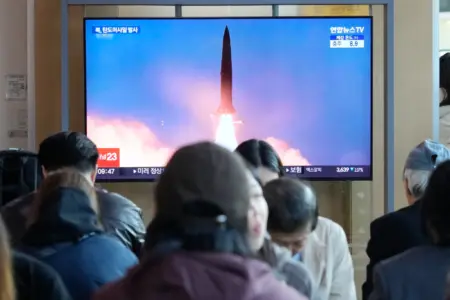Chinese spy balloon, a new war, or the US overreacting?
The suspected Chinese spy balloon – shot down by the US air force, is a story that has intrigued the world, provoked international panic and introduced the young to an old concept.
Spy balloons are not new, in fact, using high-altitude balloons for spying and military missions is a practice that dates to the middle of the last century. They’re cheaper than satellites and can operate between 80,000-120,000 feet.
The suspected spy balloon was shot down on February 4 2023, after being seen in North American airspace, including Alaska, western Canada, and the contiguous US. It was downed on February 4 off the coast of South Carolina.
Debris recovered includes the balloon sensors, which are being examined by the FBI. Three other objects were shot down in the days following, but US officials have acknowledged that it’s likely the three UFOs were unrelated to Chinese spying, but it won’t be fully understood until debris is recovered and analysed.
China has denied the balloon is a surveillance balloon and says it was merely a weather-monitoring airship that had blown off course.
What have we learned?
There is a layer of the sky – above where commercial airplanes operate and below satellite orbits, that many believe are empty space. But the Chinese spy balloon debacle has many asking – what else is up there? From Weather and scientific balloons to spying and communication balloons, to UFOs and sky trash, there’s more above our heads than most realise.
Two of the most concerning aspects of the spy balloon news are the ‘huge payload’ and the global spying from China.
US officials said the balloon was carrying a “jetliner”-sized payload and it was equipped with antennas and sensors that could pick up communication. The equipment suggests that the balloon was able to provide information that a typical satellite cannot. At the very least, such balloons can hover over one location longer.
And further fears were stoked when the US said this wasn’t the first time spy balloons had entered US airspace. Spy balloons have been seen in Florida, Guam, Texas and Hawaii – where a balloon crashed in June.
They also confirmed China has been using balloons to spy on other countries as well – in fact at least 40 countries in recent years, according to the US.
Is this a new type of war?
The Guardian claims the Chinese spy balloon has ‘waken’ up the world to a ‘new era of war’ which is at ‘the edge of space.”
The newspaper says the ‘poor man’s satellites’ offer a cheap way of ‘exploiting a previously inaccessible high-altitude level of the skies.’
The events of that week raise questions about the future of global surveillance and rivalry at the edge of the Earth’s atmosphere.
Whilst the world was focused on the balloon floating across US airspace, there was another balloon, which was flying over Costa Rica and Venezuela.
Colombia’s airforce decided to allow the balloon to fly away as they decided it posed no threat “to national security and defence, or to aviation security”.
The article goes on to say, the stakes in the Latin American balloon incident may not have been as high as in the US case, “as it did not bring the aircraft of one nuclear weapons power in direct conflict with the aircraft of another,” and there was not the same level of public calls for military action to down the balloon. But, the article says, the legal issues are the same.
The US won’t confirm how it knows that Chinese spy balloons have been flown over 40 countries on five continents, but they’ve said they are consulting affected allies and partners, ‘to galvanise a global response to China’s balloon operations and put a stop to them.’
The paper says amid the diplomatic fallout, it’s unclear if we are “witnessing the dawn of the second age of the balloon, some 86 years after the Hindenburg airship disaster put a fiery end to the first.”
Certainly, the basic technology pioneered by the Montgolfier brothers in 18th-century France is getting another look
The Guardian
A new dawn for spy balloons
High-altitude balloons are being looked at by several countries for military and security uses.
Articles published in the People’s Liberation Army Daily in recent years show China’s interest in spy balloons.
A 24 December 2021 article, titled: “Balloons – why a tool that looks ordinary has been so valued in the military realm?.” The article points to the long history of military balloons in China, tracing them back to the 10th-century Five Dynasties and Ten Kingdoms period.
The modern military use, the article says, includes scouting and surveillance, communications relay when other means are down, air defence using tethered balloons, and guiding air strikes.

Balloons could be used to launch missiles
The article claims the US military was planning to use spy balloons.
An expert suggested that spying may just be one of the multiple roles for specialised balloons in a new age of warfare. Jacob Stokes says the balloons could also serve as backup communications relays if satellites are knocked out or blinded by counter-measures. The balloons could also serve as a mother ship, carrying a canister containing a swarm of drones that could be unleashed on enemy territory. They could also be effective as a high-altitude platform from which to launch missiles.
DID THE US OVERREACT?
It was a dramatic week, with spy balloons, rising diplomatic tensions, and the dramatic downing of three further UFOs, but one American journalist claims America’s reaction to the suspected spy balloon was the most concerning aspect of the whole thing.
Writer Howard W. French, a columnist for Foreign Policy, claims the United States is so unused to being challenged and so filled with anxiety over China, the US is unable to give a “sober” response to situations such as the spy balloon.
The article notes the balloon incident highlighted two important things: China felt no need to conceal its information gathering, not even attempting to offer up a story that’s particularly believable, and two the US needs to calm down.
And by the way: China, if you’re listening—which, you obviously are—next time, why don’t you make your balloon the color blue so we can’t see it in the sky
Chelsea Handler
The article claims America’s overreaction was a result of not being “systemically challenged by anything like a peer competitor since the demise of the Soviet Union.” He says China’s openness to show who they really are is “more manageable” than its previous era of “camouflaged ambition.” He writes, “it’s the United States’ recent response, frankly, that worries me more.”
The US is now rushing toward the kind of industrial policy that focuses on the manufacturing of computer chips, with a little review of the efficacy of past efforts of this kind, including by China, with many experts calling it a costly failure.
The article goes on to say that “trying quiet diplomacy” with China might have been the most sensible.
The United States betrays its own values at deep cost to itself—both domestically, in terms of the health of its polity but also in terms of the value proposition that it presents to the world
Howard W. French
“Level-headed and discreet but hard-nosed policymaking like this toward China seems almost like an impossible dream now. In its increasingly excited responses to Beijing’s perceived challenge, the United States betrays its own values at [a] deep cost to itself—both domestically, in terms of the health of its polity but also in terms of the value proposition that it presents to the world.”
-
Why Southeast Asia’s fight against smoking isn’t over
Most Southeast Asian countries have strengthened their policies on taxation, packaging, advertising bans, but the biggest hurdles are the Tobacco companies, they own most of the politicians and have a mafia -like lobby group.
-
Leicester City’s Premier League triumph 10 years later
Cliff Notes – Leicester City’s Premier League triumph 10 years later Leicester City’s 2015-16 title win is celebrated as one of the greatest underdog stories in sports, with players reflecting on their varied experiences of that season nearly a decade later. The team’s success stemmed from lineup stability, effective counterattacking tactics, and the inability of
-
Netanyahu is learning limits of what can be achieved by military power alone
Cliff Notes – He has alienated Jews around the world, to save himself from prison The aftermath of the October 7, 2023, attacks reshaped the Middle East significantly, altering Israel’s military approach towards Hamas and leading to an unprecedented civilian death toll in Gaza. Israel has adopted a more aggressive stance, aiming for a decisive




